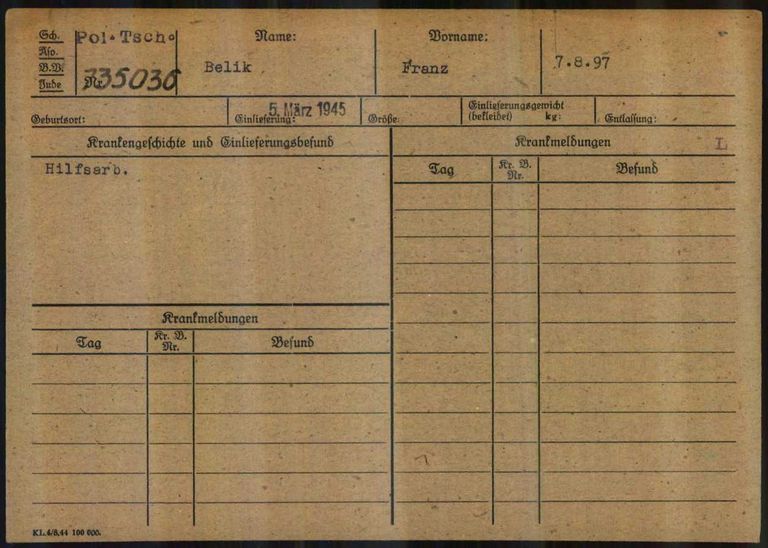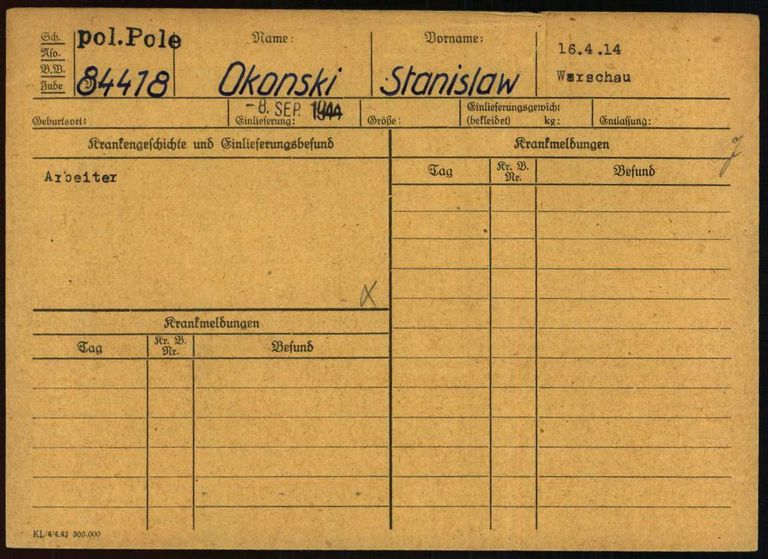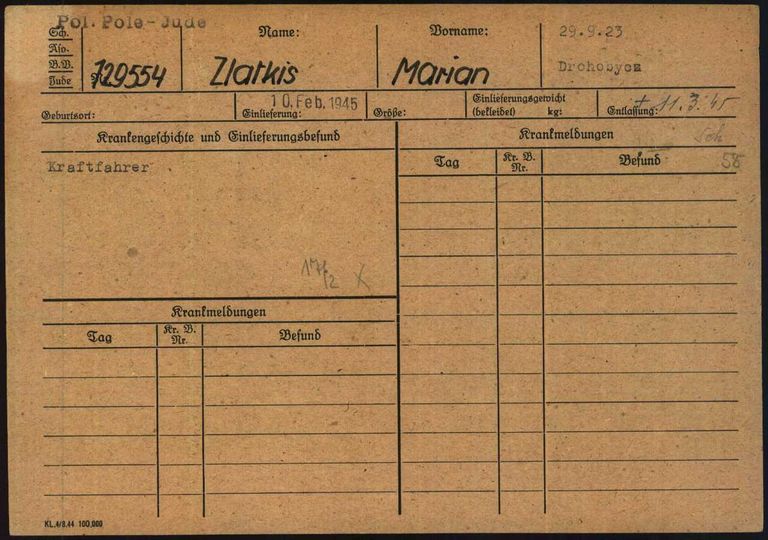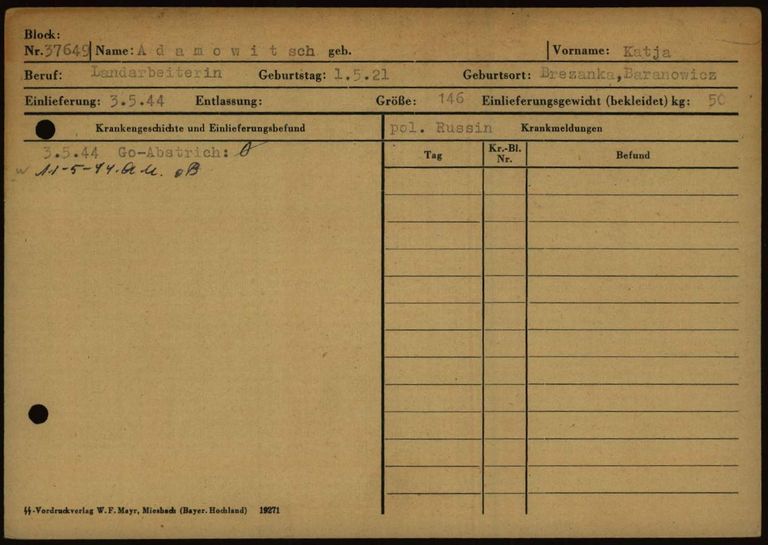Page of
Page/
- Reference
- Intro
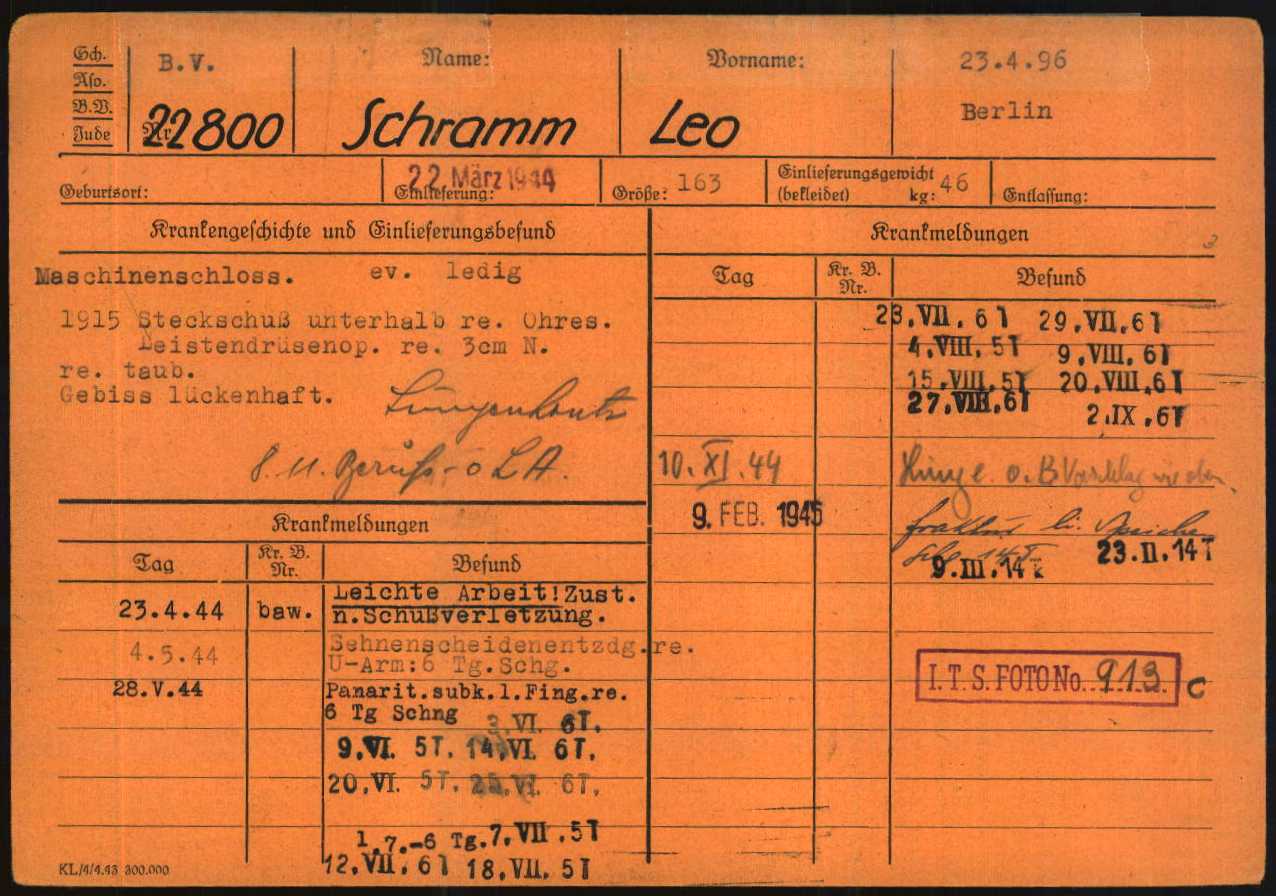

This document is a sick bay card. These cards were kept in the sick bays of the main camps. They come in different colors and were filled out either by hand or on a typewriter. The individual sick bay cards vary in their level of detail. Some cards only list the name and number of the prisoner, but others include the entire course of a prisoner’s illness.
This document is a sick bay card. These cards were kept in the sick bays of the main camps. They come in different colors and were filled out either by hand or on a typewriter. The individual sick bay cards vary in their level of detail. Some cards only list the name and number of the prisoner, but others include the entire course of a prisoner’s illness.
Questions and answers
-
Where was the document used and who created it?
The prisoner clinic was responsible for providing medical care to the prisoners in the concentration camp. In this clinic, prisoners worked as medics and nurses under the leadership of SS doctors and the supervision of the sick bay kapo. These prisoners often did not have the necessary medical knowledge to perform this job. It was not until 1939 that trained doctors who had come to the camp as prisoners were assigned to work in the clinic. In theory, there were outpatient and inpatient departments, tuberculosis departments, prisoner laboratories, eye clinics, dentists and recuperation rooms. But how a prisoner clinic was equipped and which departments actually existed varied among the concentration camps. The clinic was also known as the sick bay (Revier) or, to be more precise, the prisoner sick bay (Häftlingsrevier). The prisoner functionaries there – known as sick bay clerks – filled out sick bay cards, medical treatment forms and medical treatment books with information on the prisoners and their illnesses.
- When was the document used?
In the first years after 1933, medical treatment books were kept in the concentration camps. Later on, it was more common for sick bay cards to be filled out when prisoners arrived at a concentration camp. The newcomers were either led directly to the sick bay, or they were taken there during the first few days of their imprisonment. Several days could pass between the prisoner’s arrival and their first medical examination.
The sick bay cards, which come in different colors depending on whatever paper was currently available, were used until 1945. In the Buchenwald and Dachau concentration camps, for example, they were filled out even in the last months of the war. At this point, masses of prisoners were arriving from the abandoned concentration camps in the east. The information on these later cards is usually very brief. The prisoners were no longer examined so that their medical history could be recorded, as they had been in earlier years. Only the prisoner’s occupation was noted on the later sick bay card.
- What was the document used for?
One of the last steps after a prisoner had arrived at a concentration camp was a medical examination by the camp doctor. During this examination, the sick bay clerk would create a sick bay card for the prisoner, unless the prisoner’s details were entered in a medical treatment book instead. We no longer know who decided which prisoners would receive sick bay cards and which would be listed in a medical treatment book. It is also difficult to say whether certain groups of prisoners were systematically excluded from medical examinations.
The sick bay cards were created during the prisoner’s first medical examination. Prisoner clerks noted the personal details and medical histories of the newcomers on the cards. Sick bay cards were also updated by the prisoner clerks if prisoners received additional medical treatment. Each time a prisoner visited the sick bay, they were given their card, which they had to present during the examination. The responsible doctor would write illness reports and diagnoses on the card. They also used the cards to decide whether or when a prisoner should be admitted to a particular station in the clinic.
The sick bay cards additionally served a very different purpose in the camps. Remarkably often, prisoner clerks would take sick bay cards that were no longer needed and use them for other card files. Because paper was generally in short supply, they would cut the cards into smaller pieces and reuse them.
- How common is the document?
Very few sick bay cards have been preserved in the Arolsen Archives. A memo from Office Group D of the SS Chief Economic and Administration Office (WVHA), which was responsible for the administration of the concentration camps, suggests that sick bay cards were not filled out for all prisoners. Instead, many prisoners were listed in so-called medical treatment books in order to save paper.
- What should be considered when working with the document?
The existence of sick bay cards should not disguise the fact that medical care in the concentration camps was catastrophic. There were never enough beds, bandages or medications to treat all prisoners. Prisoners often had to share sickbeds. Their general weakness and malnourishment as well as the heavy physical labor they had to perform made the prisoners susceptible to disease in the camps. If they did get sick, it would take a long time to recover because of their vitamin deficiency, and wounds were very slow to heal. Some illnesses, such as hunger edema, were caused by the poor living conditions in the camps and were very widespread. In his diary, the Norwegian Odd Nansen recalled a conversation in Sachsenhausen in October 1943. When he asked what his fellow prisoners had died of, he received the following response: “Scheisserei, boils and pneumonia, most of them. They went to the ‘ambulance’ and if they hadn’t over 40 degrees of fever they just got a kick in the arse and had to go away. If they had more than 40 degrees they got some pills or so forth – they might be put in the Revier – or they might have to go back to the block.” (Odd Nansen: From Day to Day, translated by Katherine John. New York 1949, p. 310)
Even in the sick bay a prisoner’s category played an important role, because different groups of prisoners received different treatment. This is why the prisoner category is also noted on the sick bay cards. Jews in particular would find it difficult or impossible to receive medical treatment. Prisoners often only received treatment or medication if they had connections to other influential prisoners.
Furthermore, admission to the sick bay did not always mean a sick prisoner would be saved. In the sick bays, prisoners were subjected to the harassment and violence of the SS men, female SS guards and sometimes even the sick bay kapos. There was also a high risk of infection. Many survivors reported that the sick bay was an especially terrifying place because prisoners were forcibly sterilized in the operating rooms, and they were also killed by lethal injections of phenol or air. The doctors would also use the prisoners for medical experiments. The historian and Dachau survivor Stanislav Zámečnik recalls that even during their initial examination, prisoners would be selected for human experiments. Furthermore, between 1941 and 1944, in the campaign known as Aktion 14f13, thousands of sick prisoners who were considered “unable to work” were selected in the sick bays in order to be murdered in the Nazi “euthanasia” facilities in Hartheim, Bernburg and Pirna-Sonnenstein. It was therefore very risky for prisoners to report to the sick bay if they were ill.
There was another side to all of this, however. Political prisoners in particular, who formed tightly knit organizations in camps such as Buchenwald, reported that prisoner doctors and clerks would deliberately falsify prisoners’ sick bay cards. In order to save patients, they would change diagnoses, report that healthy prisoners were actually sick, or say that prisoners were unable to be transported if deportations to other camps had been announced. If sick prisoners were at risk of being deliberately murdered, the clerks could save their lives in some situations by sugarcoating their state of health on their sick bay cards.
If you have any additional information about this document or any other documents described in the e-Guide, we would appreciate it very much if you could send your feedback to eguide@arolsen-archives.org. The document descriptions are updated regularly – and the best way for us to do this is by incorporating the knowledge you share with us.
Variations
Help for documents
About the scan of this document <br> Markings on scan <br> Questions and answers about the document <br> More sample cards <br> Variants of the document
